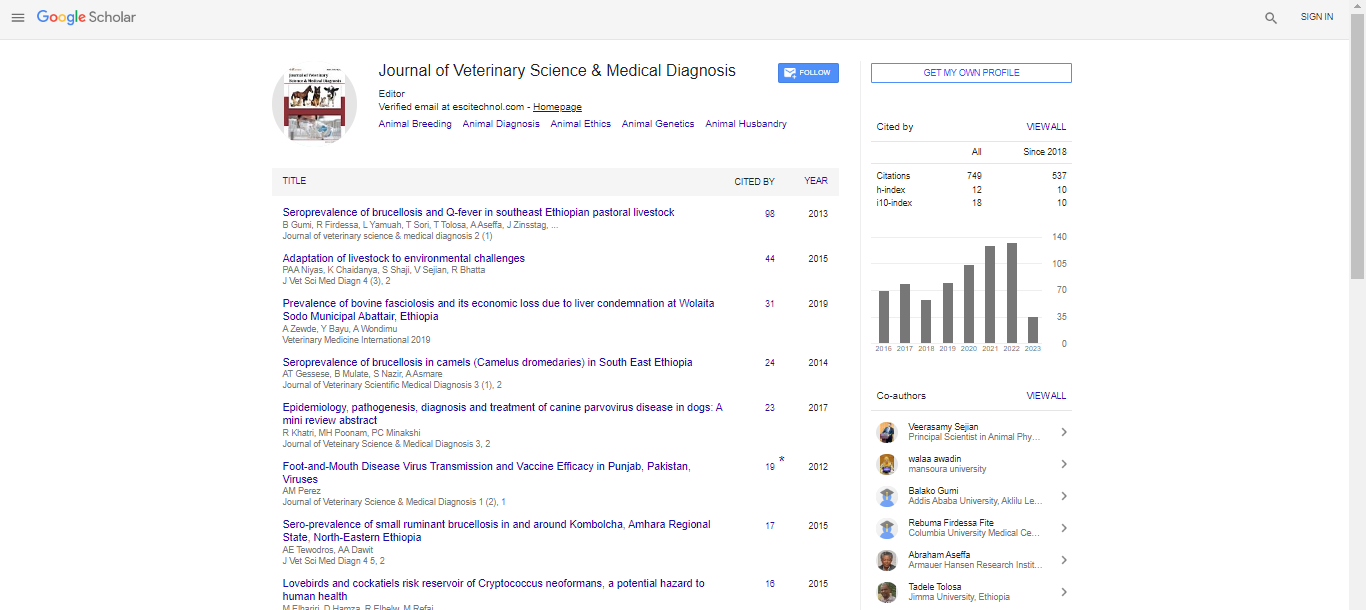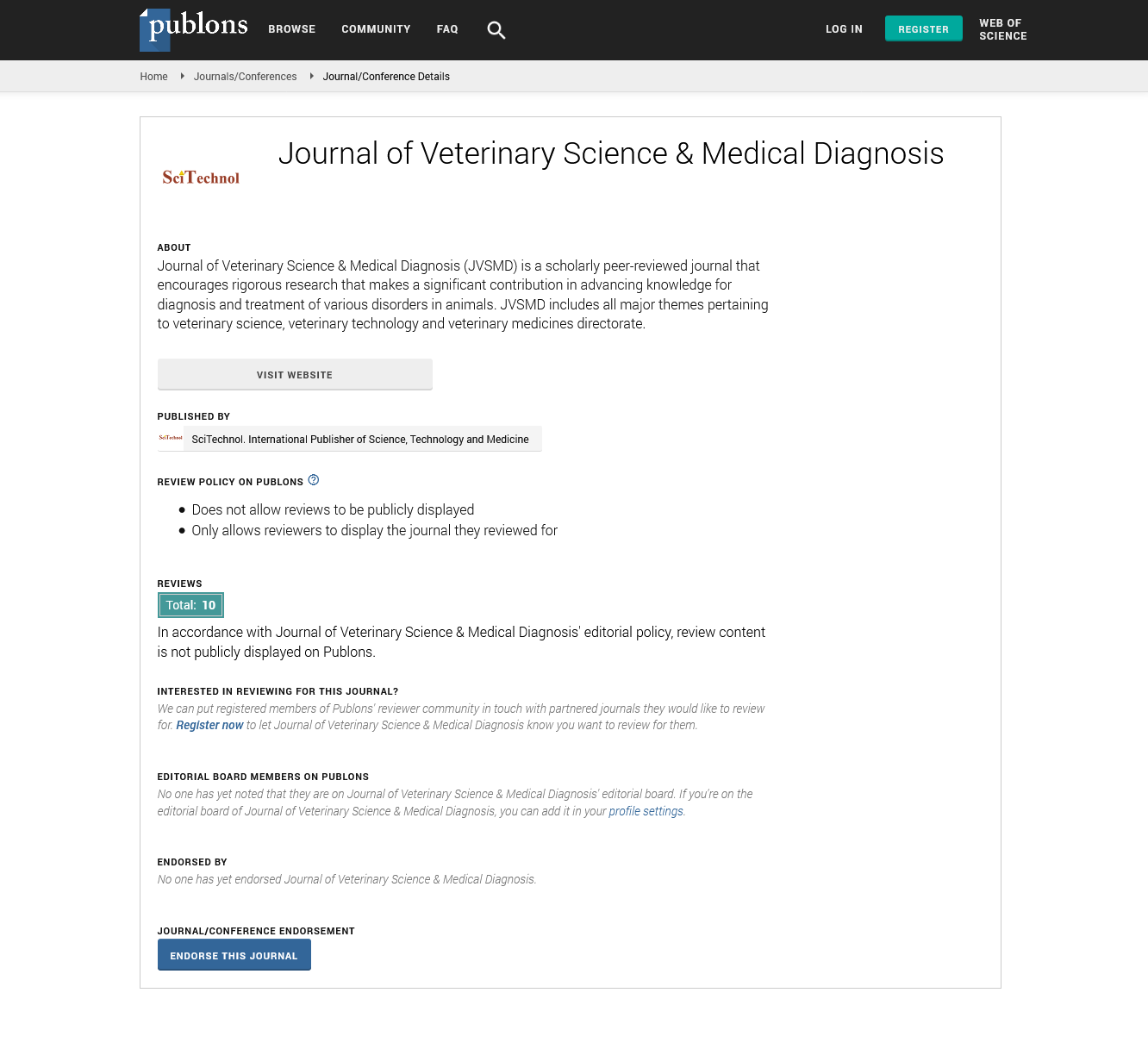Perspective, J Vet Sci Med Diagn Vol: 12 Issue: 1
Essential Nutrients for Animal Health and Development
Richard Laven*
Department of Veterinary Pathology, Massey University, Palmerston North, New Zealand
*Corresponding Author: Richard Laven
Department of Veterinary Pathology,
Massey University, Palmerston North, New Zealand
E-mail: mantonikolaidi@gmail.com
Received date: 02 January, 2023, Manuscript No. JVSMD-23-95347;
Editor assigned date: 04 January, 2023, Pre QC No. JVSMD-23-95347(PQ);
Reviewed date: 18 January, 2023, QC No. JVSMD-23-95347;
Revised date: 27 January, 2023, Manuscript No: JVSMD-23-95347(R);
Published date: 03 February, 2023, DOI: 10.35248/2325-9590.23.12.100037.
Citation: Laven R (2023) Essential Nutrients for Animal Health and Development. J Vet Sci Med Diagn 12:1.
Description
Essential nutrients are substances that animals need to obtain from their diet because they cannot synthesize them themselves. These nutrients are important for optimal animal health and performance. Animals require a balance of these nutrients to maintain a healthy body, reproduce, and grow. The five essential nutrient groups for optimal animal health and performance are carbohydrates, proteins, fats, vitamins, and minerals.
Carbohydrates are a primary source of energy for animals. They are found in plants and are broken down in the animal’s digestive system to provide glucose, which is used as fuel for cells. Carbohydrates can come in different forms such as simple sugars or complex carbohydrates like starches and fibers. The amount of carbohydrates required varies depending on the animal's activity level and the type of animal. For example, horses and other performance animals require more carbohydrates than sedentary animals like cows or goats. Proteins are another essential nutrient group that is important for building and maintaining tissues in the animal's body. Proteins are made up of amino acids, which are the building blocks of protein. Amino acids can be synthesized in the body or obtained from the diet.
However, some amino acids cannot be synthesized and must be obtained from the diet, which is why these are known as essential amino acids. Animals that require high levels of protein in their diet include growing animals, lactating females, and animals that are recovering from an injury.
Fats are also an essential nutrient group that provides energy and is important for proper cellular function. Fats are broken down in the animal's digestive system to produce fatty acids, which are used for energy and other functions. Fats also provide insulation for the body and protect internal organs. Different types of fats have different effects on the animal's health. For example, omega-3 and omega-6 fatty acids are important for brain function and inflammation, while saturated fats are linked to heart disease in humans. Vitamins are organic compounds that are essential for the animal's body to function properly. They are classified as either fat-soluble or water-soluble. Fatsoluble vitamins are stored in the animal's fat cells and can accumulate to toxic levels if consumed in excess. Water-soluble vitamins are not stored in the body and are excreted through urine, so they must be consumed regularly. Different vitamins have different functions, such as vitamin A for vision, vitamin D for calcium absorption, and vitamin E for immune function. Minerals are inorganic substances that are essential for the animal's body to function properly. They are required in small amounts, but their deficiency or excess can lead to health problems. Some minerals are required in larger amounts, such as calcium and phosphorus, which are important for bone development and maintenance. Other minerals, such as zinc and copper, are important for enzyme function and immune system function. The optimal amount of essential nutrients required for each animal varies depending on the animal's age, breed, sex, activity level, and health status. For example, a lactating cow requires more protein and energy than a non-lactating cow. Similarly, a young, growing animal requires more protein and energy than an adult animal. The nutrient requirements for each animal species are well-established and are used to develop animal feed formulations that meet the nutritional needs of the animals.The optimal amount of each nutrient required varies depending on the animal's age, breed, sex, activity level, and health status.
 Spanish
Spanish  Chinese
Chinese  Russian
Russian  German
German  French
French  Japanese
Japanese  Portuguese
Portuguese  Hindi
Hindi 
